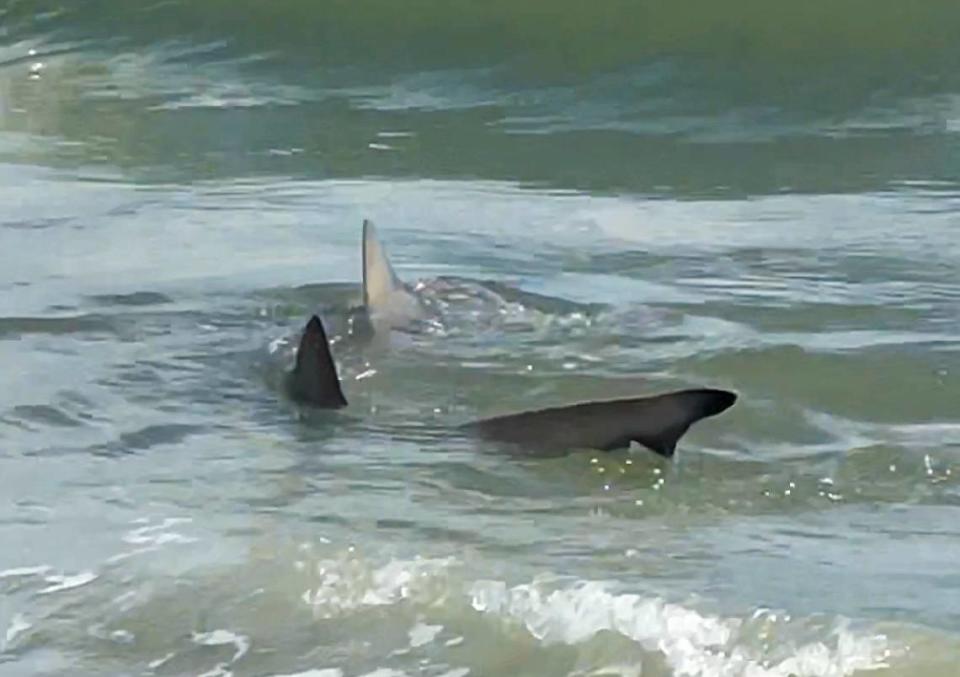As summer visitors arrive to Myrtle Beach, sharks are making plans to leave. But when?

Peak tourism season in Myrtle Beach means its waters are hardly ever empty on sunny days — the perfect Hollywood backdrop for a scary shark tale.
But in reality, the ocean’s greatest predators move to their own rhythm, rarely bite humans unprovoked and are mostly headed into more northerly seas for the rest of the year.
Between 2011 and 2020, more than 3,400 people were killed in airplane crashes. Over the last three decades, scientists have recorded less than 300 fatal shark attacks out of nearly 3,000 encounters.
By comparison, mosquitoes kill nearly one million people annually, while dogs are responsible for 30,000 deaths globally. Even freshwater snails, which carry a parasitic disease called schistosomiasis, claims more human lives than sharks.
Even so, a recent study commissioned by the Florida Panhandle’s tourism association suggests some swimmers would go to jaw-dropping lengths if it meant a face-to-tooth memory.
Out of the 1,000 adults surveyed, 17 percent said they’d voluntarily accept a non-lethal chomp if it meant being the subject of headlines and news stories.
FloridaPanhandle.com this week also published an interactive shark attack map. Among its findings:
Over the last 47 years, great white, bull and tiger sharks have cataloged the most unprovoked attacks, at 398. All three species are known to travel off the Carolina coasts.
Most attacks happen on Saturday afternoons in July.
GPS-powered tracking data from OCEARCH tagged sharks show large groups of them headed toward Canada’s Newfoundland Sea as of June 4, though others remain as far south as the Mexico coast and into parts of Central America.
Just before Memorial Day weekend, the 883-pound subadult great white Freya pinged underwater around Onslow Bay, North Carolina, about 100 miles from downtown Myrtle Beach.
Shark sightings in the region’s temperate waters are a fairly common and always buzzworthy occurrence, and the Carolinas are known for their appeal to the animals.
In late October 2022, two tagged great whites breached the water just long enough to ping. One was 1,308 pounds tracked off Myrtle Beach and the other 9-foot-9-inch predator was identified 125 miles to the north.
Sharks spend about half the year in SC
With more than 40 species swimming through the Grand Strand’s seas, the odds of seeing that telltale dorsal fin — or some other body part — are most likely from early May through late October.
Sharks have voracious appetites, with some species in captivity eating between one and 10 percent of their body weight every week.
Nearly every type is also cold blooded, so when water temperatures remain below 68 degrees it can affect their highly attuned sense of vision, impact muscle mass and create breathing problems. East Coast sharks leave for friendlier, warmer waters to avoid those kinds of health risks.
Sharks don’t like the taste of human flesh
Despite their Hollywood reputations as man-eating killers, sharks aren’t natural predators to humans. Usually, a shark-on-human attack is a case of mistaken identity.
But when it happens, it can become international news. That was the case in August 2022 after The Sun News first reported that two swimmers were bitten by a shark on the same day, sparking a global wave of coverage.
“Sharks evolved millions of years before humans existed and therefore humans are not part of their normal diets. Sharks are opportunistic feeders, but most sharks primarily feed on smaller fish and invertebrates,” the National Oceanic and Atmospheric Administration explains on its website.
“Sharks have been known to attack humans when they are confused or curious. If a shark sees a human splashing in the water, it may try to investigate, leading to an accidental attack.”
And here’s a little bit of science to explain why shark bites are even rarer here than other parts of the southeastern United States.
“Because the continental shelf runs about 50 miles offshore in North Myrtle Beach, the estuaries where the sharks gather to breed and feed are generally much farther away from visitors here than in places like Florida, where the shelf is just one mile from shore at some beaches,” MyrtleBeach.com explains.

 Yahoo Sports
Yahoo Sports 